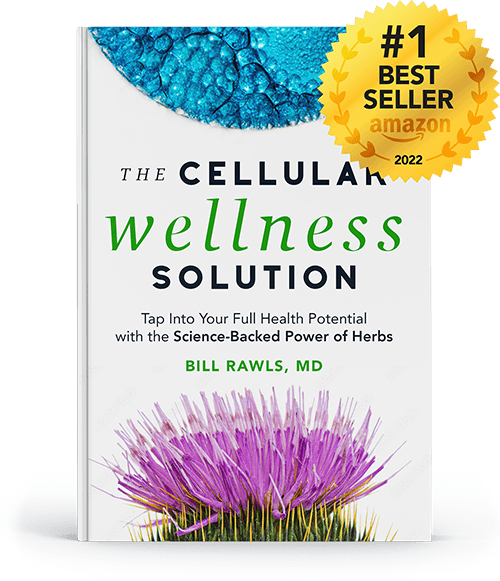What is Chinese Salvia?
Chinese salvia is a graceful-looking plant with delicate purple flowers native to China and Japan and can most commonly be seen growing on forest floors and hillsides.
A perennial, Chinese salvia belongs to the mint family and the Salvia genus, which also includes common sage.

Chinese salvia bears bold red roots, where much of its medicinal value is located. Appropriately, its epithet miltiorrhiza comes from the Greek words, miltos and rhiza, meaning “red lead” and “root,” respectively.
Chinese salvia has been a prized medicinal herb in China and other Asian countries for many years. It is used extensively to support optimal cardiovascular function and many other systems of the body.
Benefits of Chinese Salvia and How It Works
Cardiovascular Health
Chinese salvia is arguably best known for its positive effects on the cardiovascular system. Known as dan shen in China, the dried root has been used extensively for cardiovascular diseases like atherosclerosis and coronary heart disease.1
There are multiple ways in which Chinese salvia exerts its beneficial cardiovascular effects. These include, but are not limited to, its anti-inflammatory and antioxidant activity, its vasodilating and hypotensive actions, and its ability to inhibit the rapid growth of certain vascular cells that can contribute to the development of atherosclerosis.2,3,4
Chinese salvia contains the phytochemical salvianolic acid A, a strong antioxidant. A 2014 animal study published in the Journal of Cardiovascular Pharmacology demonstrated that salvianolic acid A could inhibit diet-induced atherosclerosis in mice. The authors attributed this effect to its antioxidant and anti-inflammatory properties.5
These antioxidant and anti-inflammatory actions offer benefits in many ways, but most notably help to inhibit oxidative stress, which can negatively affect vascular wall health and structure. Additionally, by balancing inflammation, there is a decrease in susceptibility to plaque formation.3
Immune Support
Chinese salvia is immunomodulating, meaning it can calm the excessive inflammation that often accompanies hyperactive immune states like autoimmunity and allergies, while also stimulating immunity against pathogens.6
In an animal study, researchers noted that different doses of Chinese salvia seemed to have different immunomodulatory effects. Higher doses displayed a potential for promoting resistance against pathogens, while lower doses inhibited IgE (an antibody involved in the allergic response).6
A 2022 in vitro article published in Cells, a peer-reviewed scientific journal, demonstrated the potential use of Chinese salvia root extract against COVID-19. The study showed that Chinese salvia could block viral entry into cells and regulate the inflammatory response.7
Although in vivo and clinical studies are needed, in vitro studies have shown that salvianolic acid B, another biologically active compound in Chinese salvia, can induce apoptosis (programmed cell death) in cancer cells by targeting cell signaling pathways and regulating energy metabolism.8

Brain Health
Chinese salvia contains powerful antioxidant and anti-inflammatory compounds that protect the brain from excessive inflammation and oxidative stress.8,9,10
In a 2017 animal study, salvianolic acid, a phytochemical found in Chinese salvia, was shown to promote autophagy (a cellular process that cleans up damaged cells). The researchers found that this mechanism resulted in neuroprotective and antidepressant effects.10
Autophagy is involved in many brain functions, and compromised autophagy is associated with several neurodegenerative diseases and mood disorders.10
Chinese salvia can also support cognitive function by reducing the accumulation of beta-amyloid protein and supporting the production of acetylcholine, a neurotransmitter that plays an important role in many different body functions.8
Kidney Protection
In China, herbal medicines are commonly used for chronic kidney diseases, with Chinese salvia being one of the most popular.
Although more research is needed, clinical studies have shown that Chinese salvia can improve kidney function in chronic disease patients through a variety of mechanisms, including enhancing the filtration of waste and excess fluids.11
A recent 2022 animal study demonstrated that Chinese salvia could alleviate kidney injury by inhibiting oxidative stress and abnormal cell death.12
Gut and Microbiome Health
More recent research points to Chinese salvia’s ability to balance the gut microbiome. In a 2018 animal study in the Journal of Functional Foods, researchers gave salvianolic acid B to mice with colitis. The study results showed that salvianolic acid B restored the diversity and richness of gut microbiota and decreased inflammation.13
History & Traditional Use
Chinese salvia is a popular herbal medicine with a long history of use for supporting various organ systems of the body and immune dysfunction.
The herb’s medicinal uses were first recorded in Shennong’s Classic of Materia Medica, the oldest medicine monograph in China.2
In traditional Chinese medicine, the dried root is highly valued and used to invigorate and move blood in conjunction with supporting the cardiovascular system, brain, healthy moods, balanced menstruation, and more.2,14
In Ancient China, decoctions (a strong tea) and pills of Chinese salvia were primarily used, but now there are many different preparations, including tinctures.
In Japan, Chinese salvia is also used to promote circulation and improve blood stasis, a more traditional term describing the slowing or pooling of blood.2
How to Use and Dosing
The dried root of Chinese salvia is most commonly used for medicinal purposes. Although it can be prepared in a variety of ways, it is convenient and effective to take it as a tincture.
The general dosage recommendation for a Chinese salvia tincture is 1.5 to 3 mL, 3-4 times per day.

For added cardiovascular support, Chinese salvia can be combined with herbs like hawthorn, garlic, ginkgo, gotu kola, milk thistle, and reishi mushroom.
For gut health and microbiome balance, try combining Chinese salvia with cryptolepis, houttuynia, andrographis, berberine, cat’s claw, and Japanese knotweed.
To enhance Chinese salvia’s neuroprotective effects, it can be combined with bacopa, ginkgo, gotu kola, and lion’s mane mushroom.
Interactions
Check with your health care practitioner if you are taking digitalis, cardiac glycosides, or hypotensive drugs, as Chinese salvia may increase their effect, so a dosage adjustment may be needed. Chinese salvia may also potentiate medications with anticoagulant properties so check with your doctor if taking blood thinners.
Always check with your health care practitioner before use if you are taking medications. For more general education on potential interactions between herbs and medications, check out Dr. Bill Rawls’ article: Is it Safe to Take Herbs with My Medications?
Precautions & Side effects
Chinese salvia should be avoided during pregnancy and should be used with caution in any situation that involves excessive bleeding, like frequent nosebleeds or heavy bleeding during menstruation.
Disclaimer: This information is intended only as general education and should not be substituted for professional medical advice. Any mentioned general dosage options, safety notices, or possible interactions with prescription drugs are for educational purposes only and must be considered in the context of each individual’s health situation and the quality and potency of the product being used. Use this information only as a reference in conjunction with the guidance of a qualified healthcare practitioner.




